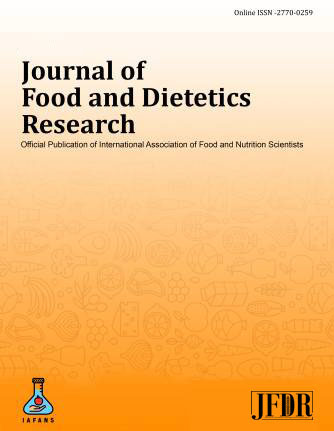In vitro starch digestibility and glycemic response of formulated barnyard millet bread
DOI:
https://doi.org/10.48165/jfdr.2025.5.1.1Keywords:
Barnyard millet, Bread, Starch digestibility, Glycemic IndexAbstract
Barnyard millet is a grain crop of drought resistant and it is generally grown as a rainfed crop and consumed just like rice with potential benefits to human health. Its digestibility of protein is 40 per cent. However, processed barnyard millets digestion properties have not been reported. So in this study, the in vitro starch digestibility and in vivo glycemic indices (GI) of raw, boiled, roasted and germinated barnyard millet incorporated bread products were investigated at the percentage of 10,20,30,40, and 50 replacing the wheat flour. The results showed that the kinetic constant, k, which reflects the rate of hydrolysis in the early stage, ranged between 0.0295 and 0.1559. The k was the lowest in roasted barnyard millet bread, and high in raw barnyard millet bread. More interestingly, the trend of C∞ and k were not fully consistent with each other. The highest incorporation of the barnyard millet flour (50%) incorporated bread showed the lower eGI. Among various processing technique, all variations of germinated barnyard millet breads showed low eGI followed by raw barnyard millet breads. Medium eGI was observed in all variations of both boiled and roasted barnyard millet breads. Therefore, barnyard millet, especially the processed millet, may serve as a potential source of nutraceutical and functional food that could delay the development of type 2 diabetes.
Downloads
References
1. International Diabetes Federation. IDF Diabetes Atlas (10th ed.). Int. Diabetes Fed. 2021; Retrieved from https://www.diabetesatlas.org.
2. Madhu SV. Youth-onset type 2 diabetes mellitus—a distinct entity? Int. J. Diabetes Dev. Ctries 2021; 41:365–368. DOI:10.1007/s13410-021-00993.
3. Mohan V, Misra A, Bloomgarden Z. Type 2 diabetes in the young in South Asia: Clinical heterogeneity and need for aggressive public health measures. J. Diabetes 2021; 13:610–612. DOI:10.1111/1753-0407.13201.
4. Wilmot E, Idris I. Early onset type 2 diabetes: Risk factors, clinical impact, and management. Ther. Adv. Chronic Dis 2021; 5:234–244. DOI:10.1177/2040622314548679.
5. Englyst KN, Englyst HN, Hudson GJ, Cole TJ, Cummings JH. Am. J. Clin. Nutr 1999; 69:448–454.
6. Nayak B, Berrios JDJ, Tang J. Food Res. Int 2014;56:35–46.
7. Lehmann U, Robin F. Trends Food Sci. Technol 2014;18:346–355.
8. Jennie B, Hayne S, Petocz P, Stephen C. Diabetes Care 2003;26:2261–2267.
9. Foster-Powell K, Holt SH, Brand-Miller JC. Am. J. Clin. Nutr 2002; 76:5–56.
10. Gelders GG, Duyck JP, Goesaert H, Delcour JA. Carbohydr. Polym 2005; 60:379–389.
11. Singh J, Dartois A, Kaur L. Trends Food Sci. Technol. 2010;21:68–180.
12. Rao DB, Malleshi NG, Annor GA, Patil JV. Nutritional and health benefits of millets. In Millets Value Chain Nutr. Secur. Indian Institute of Millets Research (IIMR) 2017;112.
13. Renganathan VG, Vanniarajan C, Karthikeyan A, Ramalingam J. Front. Genet 2020; 11:500.
14. Verma S, Srivastava S, Tiwari N. J. Food Sci. Technol 2015;52:5147.
15. Lohani UC, Pandey JP, Shahi NC. Food Bioprocess Technol 2012; 5:1113.
16. Dimri S, Singh S. J. Food Process. Preserv 2022;46: e16718.
17. Kim JY, Jang KC, Park BR, Han SI, Choi KJ, Kim SY, Seo WD. Food Sci. Biotechnol 2011;20:461.
18. Verma VC, Kumar A, Zaidi MGH, Verma AK, Jaiswal JP, Singh DK, Agrawal AS. Int. J. Curr. Microbiol. Appl. Sci 2018; 7:211.
19. Ugare R, Chimmad B, Naik R, Bharati P, Itagi S. J. Food Sci. Technol 2014;51:392.
20. Birania S, Rohilla P, Kumar R, Kumar N. Post-harvest processing of millets: A review on value-added products. Int. J. Chem. Stud 2020; 8:1824–1829.
21. Nazni S, Devi S. Effect of processing on the characteristic changes in barnyard and foxtail millet. J. Food Process. Technol 2016; 7:1–9.
22. Dewettinck K,Van Bockstaele F, Kuhne B, Van de Walle D, Courtens TM, Gellynck X. Nutritional value of bread: Influence of processing, food interaction, and consumer perception. J. Cereal Sci 2008; 48:243–257.
23. Lakshmi KP, Sumathi S. Effect of consumption of finger millet on hyperglycemia in non-insulin dependent diabetes mellitus (NIDDM) subjects. Food Nutr. Bull 2002;23(3):241–245.
24. AOAC 992.23-1992. Crude protein in cereal grains and oilseeds: Generic combustion method 1998.
25. Folch J, Lees M, Sloane Stanley GH. A simple method for the isolation and purification of total lipids from animal tissues. J. Biol. Chem. 1957;226(1):497–509. DOI: 10.1016/S0021-9258(18)64849-5.
26. Englyst N, Kingman S, Cummings J. Eur. J. Clin. Nutr. 1992;46: S33–S50.
27. Englyst KN, Englyst HN, Hudson GJ, Cole TJ, Cummings JH. Am. J. Clin. Nutr. 1999; 69:448–454.
28. Goñi I, Garcia-Alonso A, Saura-Calixto F. Nutr. Res. 1997; 17:427–437.
29. Ravi JL, Rana SS. Maximizing the nutritional benefits and prolonging the shelf life of millets through effective processing techniques: A review. ACS Omega 2014; 9:38327–38347.
30. Taylor JRN, Kruger J. Sorghum and millets: Food and beverage nutritional attributes. In Sorghum Millets Elsevier 2019;171–224.
31. Gaikwad V, Rasane P, Singh J, Idate A, Kumthekar S. Millets: Nutritional potential and utilization. Pharma Innov. 2021;10(5):310–313.
32. Sruthi NU, Rao PS. Effect of processing on storage stability of millet flour: A review. Trends Food Sci. Technol. 2021; 112:58–74.
33. Singh J, Dartois A, Kaur L. Trends Food Sci. Technol. 2010;21:168–180.
34. Brouns F, Bjorck I, Frayn K, Gibbs A, Lang V, Slama G, Wolever T. Nutr. Res. Rev. 2005; 18:145–171.
35. De la Hera E, Rosell CMM, Gomez M. Food Chem. 2014;151:526–531.




